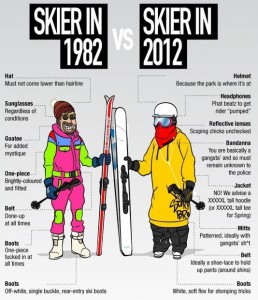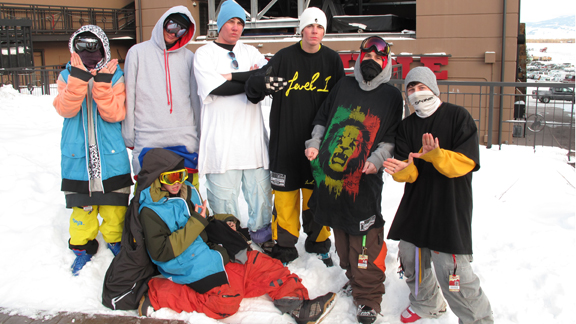While the sport of snowboarding came to the mainstream post-1960, it had already started from the first decade of the 20th century. Evidence shows that folks were then sledding through snow down slopes and hills for the sheer fun of it. Some even used sledges to add the flair in what became a world sport. They may have not known the name of the game but they all had a hand in the invention and growth of the sport.
The snowboard fashion that now includes everything from baggy and tight jeans to the tall tees, was apparent as early as 1939. The sport turned professional for the first time in the 1960s, punctuated by advanced feet gear that skaters fastened to their feet to enable them take rapid slides through the ice.
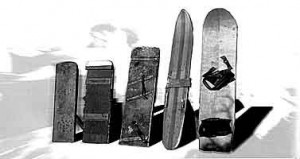
The Real Dawn of Snowboarding
There are certain people who had the biggest impact the inception and growth of snowboarding. M.J. Burchett, popularly known as Jack, had a lot to do with the way modern snowboarding developed into a modern sport.
In 1929, Burchett curved out smooth planks of plywood and secured his feet on them using pieces of cloth strands and horse’s reins. This was later to be regarded as the first snowboard. Although this is a dwarf achievement of what you see today, it was still the first major improvisation towards a safe and successful snowboarding experience.
After Burchett’s phenomenal attempt to build a snowboard, the world had to wait for almost 3 decades to witness another major snowboarding brain child. This time it was Sherman Poppen, a chemical gas engineer from Muskegon who contributed to this sport. In 1965, Sherman invented the snurfer. He bound two skis and attached a rope at the front end. A rider would then hold the rope to bring more balance and stability. Many people, including his daughters, wanted to have Sherman’s device. Due to this high demand, Sherman partnered with a manufacturer to produce the snurfers.
By 1966, more than half million snurfs were sold. Sherman conducted competitions to promote the use of the device. Many critics considered it a device for the kids. One Jake Burton participated in the competitions and was thrilled by the idea behind the snurfs. Although he broke his collarbone while skiing, Burton liked the snowboarding idea and made it popular among kids in his small town. The sport picked good momentum and the snurfs were bought aggressively.
In 1969, Dimitrije Milovich came up with the real snowboarding turner invention. He was taking some slides down a hill using a cafeteria plate when the big idea struck home. He started making snowboards similar to the modern surfboards. To take his invention full scale, Milovich started Winterstick in 1972. This was the company which commercially produced his snowboards.
He wrote some promotional articles in the “Powder”, “Newsweek” and “Playboy”. These publications were widely read and helped in building a reputation for Milovich’s snowboards and the entire snowboarding sport. Milovich left the snowboard business in 1980 but the sport was more popular than it was before his great invention.
Jake Burton had gone to NYU and never forgot about Sherman’s snurfs. In 1977 he graduated and relocated to Londonderry in Vermont. He started a venture to make advanced forms of the snurfs. He made them out of laminated wood and they became a favorable tool among the sport’s growing enthusiasts. Jack even won a snowboarding competition on one of his boards.
In the same year when Burton was enjoying tremendous success with his devices, Tom Sims entered the competition with his own version of snowboards. Sims glued pieces of carpets together and bound them to a wooden board. He then added an aluminum sheath at the bottom. In 1977, with the help of Chuck Barfoot, Sims was able to produce more of his snowboards for commercial purposes. He used his garage as the production factory. Sims named his brand of snowboards “Flying Yellow Banana”.
It was Burton who eventually made a huge leap towards modernizing snowboarding. In 1980, Burton used P-Tex base in combination with the already existing technology to make better snowboards. To counteract Burton’s advanced techniques, Sims entered into a contract with Vision Sports to boost his financial power. Barfoot was now left out and he tried to compete with both Burton and Sims to no avail.
The first snowboarding event was held in 1982. The race which attracted many competitors took place in Suicide Six in Vermont. This event set the stage for a more aggressive participation and recognition of snowboarding. Another major snowboarding event followed in 1985.
Meanwhile a number of renowned magazines were writing on snowboarding thus making it a more popular sport. They included “Snowboarder”, “International Snowboarding Magazine” and “Absolutely Radical”. In 1986, Regis Rolland (a French snowboarding enthusiast) started a show dubbed “Apocalypse Snow” which gave rise to multiple European snowboarders. The Swiss Snowboarding Championship at St. Moritz was borne out of this show.
Enter Snowboard Fashion
Snowboard fashion on the other hand has remained largely stylish and informal. Tall clothing such as tall tees in particular has been a dominant part of this sport and contributes to the extraordinary fancy street-culture gear that makes the game amusing, funny and cool.
Here now is a time-line of snowboard fashion, starting appropriately in 1939.
The Late 1930s
Way before long hoodies took the scene by the storm in the early ’90s, snowboard fashion had captured the world with the cap as a basic item of head wear. This would soon evolve to helmets.
In 1939, the flat hat became an iconic part of the day-to-day snowboarding wear. Children would sport it together with a combination of a woolen pullover with a muffler inside, as well as long snurfing boots reaching up to the upper chins. It is in these boots that kids would tuck in their patent trousers that had buttons on the sides just like today’s sports clothing.
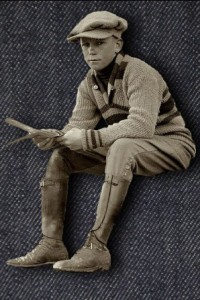
The Flashy ’60s
Zoom in two decades later into the 1960s and you find the epitomization of the really glamorous sense of clothing even for a snowboarder. The cutting-edge fashion of the time was sometimes Christmas-inspired with snowboarders turning into a more and more fancy sense of dress with jumpers, woolen scarves and hand protectors. Woolen marvins took over after the heyday of the flat hat of the late 1930s.
Snowboarding started growing into American mainstream sporting during this period, as kids went crazy with the sport. In fact what we value now as very cool was already in vogue then. The Surf Champions of the 1960s usually wore paraphernalia that might pass as very cool today. Good examples include sunglasses and a pair of jeans which simply became an everyday fashion in the streets. The champions also wore some marvin and long hoodies perhaps to protect against cold, not forgetting gloves to top up of course!
The sixties was essentially the age of flashy style that presaged the start of urban snowboard fashion in the years that followed. Though the baggy style had not yet made its appearance, this was a time that paved the way for later unconventional styles.
The Fancy ’70s
The era of the long tees was yet to hit center-stage by the time the party-influenced snowboarding era of the 1970s came up. Indeed, here you could find daredevils trying every kind of fashion. Principal among these were Jake and Tom who went into a lighter style that tended towards skinny leggings, that looked almost like today’s swimsuits! There were sunglasses too, and small coats to cover the snowboarder on the ice cold surface.
Interestingly in the seventies, some of these guys cruised over snow without any hoodies or protective clothing. No wonder their coolness ended up bringing them face to face with extremely low temperatures.
Finally, the seventies era was all about taking advantage of the new artificial fabrics like waterproof jackets. The big idea then was to stay ahead of others by being daring in snow and wearing as fancifully as possible. This was even as the snowboard fashion calendar was ticking towards the next decade that would mean big business for the companies that began making snowboard wear.
The 1980s: Snowboarding Attracts Fashion Lines and Magazines
Perhaps no other decade in the time-line of snowboard fashion has had a larger impact in the incorporation of professional bodies like publishers and magazines into the snowboarding world than the eighties.
Key trends of this era included:
1987: A new journal devoted to the winter sport, known as Transworld SNOboarding Magazine, printed its initial feature later in the year.
1988 saw a well-known brand, Ocean Pacific, begin its snowboard fashion line.
In the later years of the 1980s, major corporations followed suit and launched their own fashion lines that were marriages of sorts featuring snowboarding and surfing fashion gear.
Here now is a look at snowboard fashion in recent decades with specific emphasis on the long t-shirt.
The 1990s Through 2000s
If funny and cool go together, then the no-nonsense styles of the nineties are the best representations of this idea. They included the amusing extra-large wear of the generation of snowboarders of between 1990 and mid-2000.
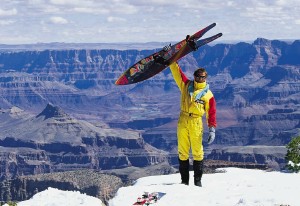
The highly urban snowboard fashion sense began with Regis Rolland in the early ’80s when the days of fancy style were dying in favor of cool matter-of-fact hip-hop and punk styles. The emphasis was to remain as far away as possible from the archetypical formal look of a skiing pro and instead retain your own unique street fashion. This is why the long-sleeve t-shirt became a hit in combination with extra large sagging pants. To make them even more cool, the enthusiasts wore these clothes in dull informal colors, and the pants had fancy patches not just on the knees but even at the seat!
Tall clothing also made its major appearance during this period, featuring high and big clothing for tall thin men. Next came the long hoods that made the rap culture seem to be part and parcel of the snowboarding world even when it was not. Like the other kinds of fashion paraphernalia, the mentality of the sportsman was to wear it in as down-to-earth a manner as possible, making them cool and manly.
However, did this style stay long as a favorite? Yes and no: as the following section will show, the above types of tall clothing still remain favorites, but the color sense changed in mid-2000s.
The Mid-2000s and Beyond
Magazines dedicated to snowboard are to blame (or to be thanked!) for the end of the earth-bound dark tinges of the nineties’ snowboard fashion. Though the sense of wearing sagging and long tees remained through the middle of the new millennium, enthusiasts changed their faith in the color department for good. They knew that magazines only featured beautiful people in flashy clothes. This is why majority jumped ship and caught up with brilliant, flashy-colored long sleeve shirts and shiny jeans that could fit the new magazine sensibilities. This is why you perhaps miss the baggy dull-colored jeans of the last two decades!
The 2010s to Present
This is the period when snowboard fashion started taking an eclectic approach, where anything goes. There is now a mixture of tall clothing especially tight jeans, though not quite as mainstream. A major trend that has died hard from the recent decades is the presence of baggy jeans with a mixture of longer t-shirts that remind you of the hip-hop and grunge days of the ’90s. They are still popular in winter sports.
The t-shirts in particular now appear cool and brilliant as preference for cool dark colors like brown, grey and black has been overtaken by shiny colors. You will still find a snowboarder sporting an extra large long hoodie that still passes as cool in this day of tight wear.
The 2010s have also seen the return of some snowboard fashion that is mainly influenced by the art of film where sports suits have replaced casual wear. However, this is only in some quarters.
The Staying Power of the Long Tees
Though the t-shirt is commonly seen as a part of clothing layers to buffer against cold among winter clothes, it is nevertheless part and parcel of exterior snowboard fashion.
In the 1990s through 2000s, the rap, grunge and punk cultures took over the style sense of snowboard fashion for good. It was common to see snowboarders come up with their own unique, rebellious clad that was a far cry from say, the beginnings of the professional sportswear in the 1930s or even the stylish ’60s and ’70s.
The tall tees that are common in major American sports like basketball and baseball made gradual entry into snowboarding. The t-shirt or hoodie had to be long in all aspects, including long sleeves and preferably with a cool picture or graphic often that was derived from street art or graffiti style. Check out the video below of a Snowboarder showing you what it means to have that Tall Tee Steeze on the Mountains.
The Rise of Water Resistant Clothing
Like in all outdoor sports that happen in winter, snowboard fashion has also evolved through the type of material that makes it. One of the most recent trends is water resistant items.
In his mid-2000s motion picture Showoffs,Tim Warwoods and his pals continued a cinematic tradition that had been showcasing snowboard fashion since the 1980s, through the silver screen. Watching the film leads to such questions as: is rubber gear worth it when you can have cheap cotton clothing with a thin layer of plastic to make it waterproof?
All in all, it is clear that various materials including polyester and synthetic fiber have become part and parcel of the post-modern era of all winter games especially snowboarding.
There was neither television nor internet when snowboard fashion began in the 1930’s. Thus, the only place you could go for snowboard gear was the nearest clothing line or mortar and brick store.
All this has changed now as the internet becomes the central marketplace for fancy types of tall clothing including snowboarding tees that now come in bright styles and XL sizes.
Here are some ideal features of today’s snowboard fashion, particularly the special long-sleeve t-shirts :
-
A size to suit your physique, preferably large.
-
Flexible weight parameters of anything around 31/2 ounces.
-
Firm yet relaxed taping of the shoulder pads.
-
Large shrunken fabric, mainly cotton, with elastic small sleeves to make it sit well on the body..
The Future
Snowboard fashion continues to attract many enthusiasts around the world, both inside and outside the sport. This is indeed a clear signal that this sport-inspired fashion will continue to grow into new heights going forward. It has already established itself as a widely acceptable cool fashion, thus creating an admirable class that will no doubt hold supreme throughout generations to come.
Snowboard as a sport might as well be the most fashionable sport in the world because it has the versatility of allowing gents and ladies to wear anything they wish: take a note of the cool sunglasses, long tees and the tight leggings of the 1970s virtuosos of the sport amid the cold and you will discover that not even cold can make people change their style.

